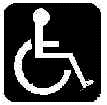

![]()
Equalization of opportunities
The rights of persons with disabilities to participate in their societies can be achieved primarily through political and social action.
Many countries have taken important steps to eliminate or reduce barriers to full participation. Legislation has in many cases been enacted to guarantee to disabled persons the rights to, and opportunities for, schooling, employment and access to community facilities, to remove cultural and physical barriers and to proscribe discrimination against disabled persons. There has been a movement away from institutions to community-based living. In some developed and developing countries, the emphasis in schooling is increasingly on "open education" with a corresponding decrease in institutions and special schools. Methods of making public transport systems accessible have been devised, as well as methods of making information accessible for sensory-disabled persons. Awareness of the need for such measures has increased. In many cases, public education and awareness campaigns have been launched to educate the public to alter its attitudes and actions towards disabled persons.
Often, disabled persons have taken the lead in bringing about an improved understanding of the process of equalization of opportunities. In this context, they have advocated their own integration into the mainstream of society.
Despite such efforts, disabled persons are yet far from having achieved equal opportunities and the degree of integration of disabled persons into society is yet far from satisfactory in most countries
Social questions
Full participation in the basic units of society family, social groups and community's the essence of human experience. The right to equality of opportunity for such participation is set forth in the Universal Declaration of Human Rights and should apply to all people, including those with disabilities. In reality, however, disabled persons are often denied the opportunities of full participation in the activities of the socio-cultural system of which they are a part. This deprivation comes about through physical and social barriers that have evolved from ignorance, indifference and fear.
Attitudes and behavior often lead to the exclusion of disabled persons from social and cultural life. People tend to avoid contact and personal relationships with those who are disabled. The pervasiveness of the prejudice and discrimination affecting disabled persons and the degree to which they are excluded from normal social intercourse produce psychological and social problems for many of them.
Too often. The professional and other service personnel with whom disabled persons come into contact fail to appreciate the potential for participation by disabled persons in normal social experiences and thus do not contribute to the integration of disabled individuals and other social groups.
Because of these barriers, it is often difficult or impossible for disabled persons to have close and intimate relationships with others. Marriage and parenthood are often unattainable for people who are identified as "disabled", even when there is no functional limitation to preclude them. The needs of mentally handicapped people for personal and social relationships, including sexual partnership, are now increasingly recognized.
Many persons with disabilities are not only excluded from the normal social life of their communities but in fact confined in institutions. While the leper colonies of the past have been partly done away with and large institutions are not as numerous as they once were, far too many people are today institutionalized when there is nothing in their condition to justify it.
Many disabled persons are excluded from active participation in society because of doorways that are too narrow for wheelchairs; steps that cannot be mounted leading to buildings, buses, trains and aircraft; telephones and light switches that cannot be reached; sanitary facilities that cannot be used . Similarly they can be excluded by other types of barriers, for example oral communication which ignores the needs of the hearing impaired and written information which ignores the needs of the visually impaired. Such barriers are the result of ignorance and lack of concern; they exist despite the fact that most of them could be avoided at no great cost by careful planning. Although some countries have enacted legislation and launched campaigns of public education to eliminate such ob- stacles, the problem remains a crucial one.
Generally, existing services, facilities and social actions for the prevention of impairment, the rehabilitation of disabled persons and their integration into society are closely linked to the Governments' and society's willingness and ability to allocate resources. income and services to disadvantaged population groups.
ABOUT ORGANIZATION |
NEW FOR DISABLED |
INFORMATION |
|
FEEDBACK |
| Feedback |
Organizations disabled persons

Consequences of economic and social development
To the extent that development efforts are successful in bringing about better nutrition, education, housing, improved sanitary conditions and adequate primary health care, the prospects of preventing impairment and treating disability greatly improve. Progress along these lines may also be especially facilitated in such areas as:
- The training of personnel in general fields such as social assistance, public health, medicine, education and vocational rehabilitation;
- Enhanced capacities for the local production of the appliances and equipment needed by disabled persons;
- The establishment of social services, social security systems, cooperatives and programs for mutual assistance at the national and community levels;
- Appropriate vocational guidance and work preparation services as well as increased employment opportunities for disabled persons.
Since economic development leads to alterations in the size and distribution of the population, to modifications in life styles and to changes in social structures and relationships, the services needed to deal with human problems are generally not being improved and expanded rapidly enough. Such imbalances between economic and social development add to the difficulties of integrating disabled persons into their communities.
![]()
Web: voinorg.narod.ru
E-mail voinorg@narod.ru
President Yuri S. Pavlenko
Copyright © 2000 Creation and design - Vladimir Tibenkov


